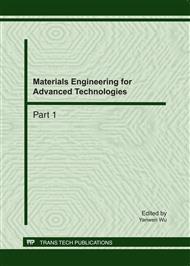p.288
p.294
p.300
p.306
p.311
p.317
p.323
p.329
p.335
Influence of the Structure of Comb-Shaped Polymer on the Adsorption between the Polymer and SO42- Ions
Abstract:
Comb-shaped hyper-branched polycarboxylate admixture polymers, both the water-reducing-type JS and slump-retaining-type BT, were prepared, and their adsorption characteristics with SO42- ions were studied by conductivity loss experiments. The results indicated that the adsorptions were related to both the content of carboxylic acid groups in polymers and the concentration of Na2SO4 solution, adsorptive action was formed by the complexation action between the carboxylic acid groups in polymers and SO42- ions, having nothing to do with polyether side chain in polymer. Comb-shaped hyper-branched polymers in aqueous solution would form association super-molecular structure, which could be destroyed by Na2SO4 solution.
Info:
Periodical:
Pages:
311-316
Citation:
Online since:
June 2011
Authors:
Price:
Сopyright:
© 2011 Trans Tech Publications Ltd. All Rights Reserved
Share:
Citation:


